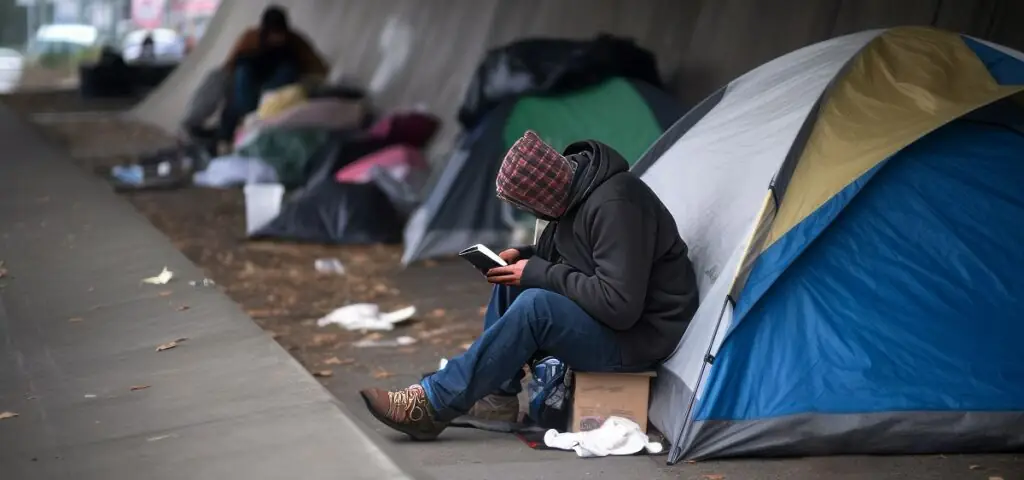Is the dismantling of makeshift shelters on public property an unconstitutional measure? This issue has made headlines several times this year.

When she unveiled her plan to tackle homelessness in mid-January, Catherine Fournier, mayor of Longueuil, cited the Canadian Charter of Rights and Freedoms and court decisions to justify why the City tolerates homeless encampments.
This stance in support of homeless encampments is similar to that held by the Mobile Legal Clinic. The Clinic is currently arguing before the courts that the City of Saint-Jérôme is violating the fundamental rights of homeless people because it doesn’t offer an adequate alternative when people are evicted from an encampment. A municipal by-law of the City of Saint-Jérôme prohibits anyone from sleeping on streets, sidewalks, parks, playgrounds or any other public place.
Landmark decisions
Two court decisions in Canada support the mayor of Longueuil and the Mobile Legal Clinic’s positions.
In 2008, the Superior Court of British Columbia recognized that cities could not use by-laws to prohibit homeless people from taking shelter at night in order to protect their lives and safety, given that these cities were unable to provide enough shelter places themselves.
In January 2023, a judge made a similar decision in Ontario. They ruled that preventing a person from living outdoors was unconstitutional if there was no available and accessible place indoors. Evicting them would violate several rights guaranteed by the Canadian Charter of Rights and Freedoms.
A risk
For Lucie Lamarche, a professor in the département des sciences juridiques (law department) at the Université du Québec à Montréal (UQAM), these decisions can be seen as a step forward for homeless people fearing that their makeshift shelters will be dismantled, but she does have some reservations about their long-term prospects.
“The risk with protecting camps is that of not investing in and promoting the right to housing,” she states in an interview with Éducaloi’s Angle Droit radio show.
However, what she finds interesting in the Ontario decision is that the judge not only considers that the number of shelter places is insufficient, “but also that these shelter places are not adequate for the needs of the people being housed.”
“An acceptable shelter is not just about having a bed and a bed count,” explains Lucie Lamarche. “It’s also about the number of places that meet the needs of homeless people.”
These needs are diverse. They may relate to a pet or personal belongings, restrictions on using substances or drinking in a shelter, potential violence, and “the gendered and racialized dimension of shelters,” says the UQAM professor.
Safety concerns
In many cases, municipalities invoked fire hazards to justify the dismantling of homeless encampments.
This was the reason given for dismantling the encampment along Notre-Dame Street East in December 2020 and that of the Boisé Steinberg in May 2021, both located in the Mercier-Hochelaga-Maisonneuve borough.
In the case of the encampment along the Notre-Dame bike path, a tent had indeed caught fire shortly before the dismantling operation, but this was not the case at Boisé Steinberg.
This safety argument is what cities have in their “toolbox” to prevent the accumulation of encampments on their territory, notes Lucie Lamarche. But she believes that this mentality is changing.
“There are fewer risks than tools available to manage the risk, and municipalities are beginning to understand that there is legitimacy to encampments,” she maintains.
Partnerships with the wider community and the presence of community workers are examples of resources that make it possible to manage encampments without dismantling them.
Social cohabitation
Neighbours around an encampment don’t always appreciate the presence of homeless people near their homes, as was the case in 2021 with a shelter set up near the Mont-Royal metro station.
Screams, broken beer bottles and violence are just some of the issues raised by local residents. The residents launched a petition calling for better control of the situation.
This challenge of social cohabitation applies to emergency shelters as well.
For example, in the Longue-Pointe neighbourhood, the presence of homeless people who were sheltered in a hotel caused a great deal of tension, prompting citizens to launch a petition.
Those who signed the petition raised several issues, including some related to cleanliness, safety, prostitution and vandalism. After several months, the homeless people in question were relocated to a church in Hochelaga, once again creating discontent among some of the locals.
“At the risk of sounding totally insensitive, I’d say we need to coexist in the public space,” counters Lucie Lamarche. This cohabitation requires support, mediation and dialogue, she concludes.





